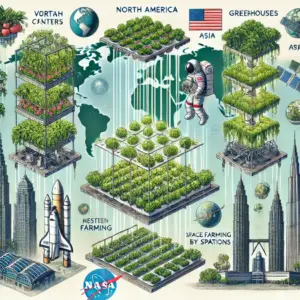Aeroponics, an innovative method of growing plants without soil by suspending roots in the air and misting them with nutrient-rich solutions, is gaining traction worldwide. Its efficiency, scalability, and sustainability make it a popular choice for modern agriculture. This article explores the various regions and contexts where aeroponics is being implemented, highlighting its benefits and applications across different parts of the globe.

The Rise of Aeroponics
Aeroponics offers several advantages over traditional farming methods, including:
-
Water Efficiency: Uses up to 98% less water than traditional farming.
-
Space Efficiency: Ideal for urban farming due to vertical growth setups.
-
Faster Growth Rates: Provides optimal conditions for rapid plant growth.
-
Disease Control: Reduces the risk of soil-borne diseases and pests.
These benefits have led to the adoption of aeroponics in various regions worldwide, from urban centers to rural areas, and even in space exploration.
Aeroponics in North America
United States
In the United States, aeroponics has found significant application in both commercial and urban farming. Companies like AeroFarms and Lettuce Grow are leading the way in utilizing aeroponic systems to grow leafy greens, herbs, and other crops.
AeroFarms
Located in Newark, New Jersey, AeroFarms operates one of the largest aeroponic vertical farms in the world. By using aeroponics, they can produce high-quality leafy greens with minimal water and space, making their produce popular in urban markets.
Lettuce Grow
Lettuce Grow offers user-friendly aeroponic systems for both commercial and home use. Their Farmstand system allows urban dwellers to grow fresh produce in small spaces, promoting local and sustainable food production.
Canada
In Canada, aeroponics is being used to address food security issues, particularly in remote and northern regions where traditional agriculture is challenging due to harsh climates. Vertical farming companies are leveraging aeroponics to provide fresh produce year-round.
GoodLeaf Farms
GoodLeaf Farms, based in Ontario, uses aeroponic systems to grow a variety of greens. Their vertical farming approach helps supply fresh produce to Canadian markets, reducing reliance on imports and enhancing local food security.
Aeroponics in Europe
Netherlands
The Netherlands, known for its innovative agricultural practices, has embraced aeroponics as part of its sustainable farming initiatives. Dutch companies are using aeroponics to enhance crop production and efficiency.
PlantLab
PlantLab, a Dutch company, utilizes aeroponics in its urban farming projects. By creating optimal growing conditions indoors, PlantLab can produce high-quality crops with minimal environmental impact.
United Kingdom
In the UK, aeroponics is being used to develop sustainable urban farming solutions. The focus is on reducing food miles and ensuring a consistent supply of fresh produce to urban populations.
GrowUp Urban Farms
GrowUp Urban Farms in London uses aeroponics to grow leafy greens and herbs in a controlled indoor environment. Their approach emphasizes sustainability and local food production, catering to the increasing demand for fresh, locally-grown produce.
Aeroponics in Asia
Japan
Japan, with its limited arable land and high population density, has turned to aeroponics to maximize food production. Vertical farming using aeroponics is helping to address food security and reduce the environmental footprint of agriculture.
SPREAD
SPREAD, a Japanese company, operates large-scale vertical farms using aeroponics. Their “Techno Farm” in Kyoto is one of the most advanced aeroponic farms in the world, producing thousands of heads of lettuce daily.
-
Learn about SPREAD
Singapore
Singapore, a city-state with limited agricultural land, has embraced aeroponics to enhance its food self-sufficiency. Urban farms using aeroponic systems are popping up across the city, providing fresh produce to local markets.
Sky Greens
Sky Greens, Singapore’s first commercial vertical farm, uses aeroponics to grow vegetables in a series of rotating towers. This innovative approach maximizes space and ensures a steady supply of fresh greens to Singaporeans.
Aeroponics in the Middle East
United Arab Emirates
In the arid climate of the UAE, traditional farming is challenging. Aeroponics offers a viable solution to produce fresh food locally, reducing the dependence on imports.
Badia Farms
Badia Farms, located in Dubai, is the Middle East’s first commercial indoor vertical farm using aeroponics. They produce a variety of leafy greens and herbs, supplying fresh produce to local restaurants and retailers.
Israel
Israel, known for its advanced agricultural technologies, has incorporated aeroponics into its innovative farming practices. This method helps conserve water and maximize yields in a country with limited natural resources.
Future Crops
Future Crops, an Israeli company, uses aeroponics to grow a wide range of herbs and greens. Their approach combines technology and sustainability, contributing to the country’s agricultural advancements.
Aeroponics in Africa
Kenya
In Kenya, aeroponics is being used to improve food security and support small-scale farmers. By adopting this technology, farmers can increase yields and reduce the need for large amounts of water and land.
FreshBox
FreshBox, a Kenyan startup, provides affordable and scalable aeroponic systems to local farmers. Their goal is to empower farmers with the tools needed to produce more food sustainably and efficiently.
South Africa
In South Africa, aeroponics is being explored as a way to boost agricultural productivity and sustainability. Research institutions and startups are working together to develop aeroponic systems suited to local conditions.
Aeroponics Africa
Aeroponics Africa is a project focused on promoting aeroponic farming across the continent. They provide training and resources to help farmers adopt aeroponic technology, enhancing food security and sustainability.
Aeroponics in Space
NASA’s Veggie Project
NASA has been exploring the use of aeroponics for growing food in space. The Veggie Project on the International Space Station uses aeroponics to grow crops like lettuce and radishes, providing astronauts with fresh food and studying the feasibility of space farming.
Conclusion: The Global Reach of Aeroponics
Aeroponics is making a significant impact around the world, from urban centers to remote regions and even outer space. Its efficiency, sustainability, and scalability make it an attractive option for modern agriculture, addressing food security and environmental challenges. As technology continues to advance, the adoption of aeroponics is likely to increase, offering a promising future for sustainable food production.
Recommended Products for Aeroponic Systems
To help you get started with aeroponics, consider these trusted products:
Lettuce Grow Farmstand
The Lettuce Grow Farmstand offers an easy-to-use aeroponic system that is perfect for both beginners and experienced growers.
Growace Nutrient Solutions
Growace provides high-quality nutrient solutions and equipment designed to optimize the performance of aeroponic systems.
NuAqua Reverse Osmosis Systems
Ensure your aeroponic system uses the purest water with NuAqua’s reverse osmosis systems, preventing issues that can affect plant health.
By understanding the global applications and benefits of aeroponics, you can appreciate its potential to transform agriculture and contribute to a more sustainable future. Happy growing!
